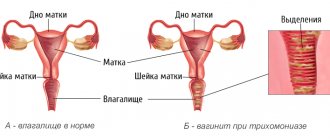Aerobic vaginitis is a type of vaginosis in which aerobic microflora completely or partially replaces normal lactoflora, resulting in inflammatory processes in the vagina. The disease is not life-threatening, but if left untreated it can cause serious complications.
Aerobic vaginitis is, in fact, ordinary bacterial vaginosis, but in the first case, the vaginal mucosa is colonized by bacteria that vitally need oxygen. Bacterial vaginosis is accompanied by the replacement of the normal microflora of the vaginal mucosa by bacteria, the vital processes of which do not depend on the presence of air.
The development of the disease is based on:
- reducing the number of beneficial bacteria that populate the vaginal mucosa;
- colonization of the mucous membrane by pathogenic or opportunistic bacteria.
However, doctors still do not know on what factors the further development of pathogenic microflora depends, and what exactly determines the type of microorganisms that will dominate in the future.
It is also unknown what exactly the development paths of aerobic and anaerobic vaginitis are, and why in some patients the vagina is colonized by oxygen-free bacteria, and in another by oxygenated bacteria. As a result, doctors diagnose pathology either during its development or at the moment when it has already formed.
Classification of anaerobes [edit | edit code]
According to the established classification in microbiology, there are:
- Facultative anaerobes
- Capneistic anaerobes and microaerophiles
- Aerotolerant anaerobes
- Moderately strict anaerobes
- Obligate anaerobes
If an organism is able to switch from one metabolic pathway to another (for example, from anaerobic to aerobic respiration and back), then it is conditionally classified as facultative anaerobes
[3] .
Until 1991, a class of capneic anaerobes
, requiring a reduced oxygen concentration and an increased carbon dioxide concentration (bovine Brucella -
B. abortus
) [2].
The moderately strict anaerobic organism survives in an environment with molecular O2, but does not reproduce. Microaerophiles are able to survive and reproduce in environments with low partial pressure of O2.
If an organism is not able to “switch” from anaerobic to aerobic respiration, but does not die in the presence of molecular oxygen, then it belongs to the group of aerotolerant anaerobes
. For example, lactic acid and many butyric acid bacteria.
Obligate
anaerobes die in the presence of molecular oxygen O2 - for example, representatives of the genus of bacteria and archaea:
Bacteroides
,
Fusobacterium
,
Butyrivibrio
,
Methanobacterium
). Such anaerobes constantly live in an oxygen-deprived environment. Obligate anaerobes include some bacteria, yeasts, flagellates and ciliates.
General properties for aerobes and anaerobes
- All these prokaryotes do not have a pronounced nucleus.
- They reproduce either by budding or division.
- When carrying out respiration, as a result of the oxidative process, both aerobic and anaerobic organisms decompose huge masses of organic residues.
- Bacteria are the only living things whose respiration binds molecular nitrogen into an organic compound.
- Aerobic organisms and anaerobes are capable of respiration over a wide range of temperatures. There is a classification according to which nuclear-free unicellular organisms are divided into:
- psychrophilic – living conditions around 0°C;
- mesophilic – temperature of vital activity from 20 to 40°C;
- thermophilic - growth and respiration occurs at 50-75°C.
Yulia Pyatirubleva
Toxicity of oxygen and its forms to anaerobic organisms [edit | edit code]
An oxygen-containing environment is aggressive towards organic life forms. This is due to the formation of reactive oxygen species during life or under the influence of various forms of ionizing radiation, which are much more toxic than molecular oxygen O2. The factor that determines the viability of an organism in an oxygen environment [4] is the presence of a functional antioxidant system capable of eliminating: superoxide anion (O2 − ), hydrogen peroxide (H2O2), singlet oxygen (1 O2), as well as molecular oxygen (O2 ) from the internal environment of the body. Most often, such protection is provided by one or more enzymes:
- superoxide dismutase, which eliminates superoxide anion (O2 − ) without energy benefit to the body
- catalase, eliminating hydrogen peroxide (H2O2) without energy benefit to the body
- cytochrome
is an enzyme responsible for the transfer of electrons from NAD•H to O2. This process provides significant energy benefits to the body.
Aerobic organisms most often contain three cytochromes, facultative anaerobes - one or two, obligate anaerobes do not contain cytochromes.
Anaerobic microorganisms can actively influence the environment [2], creating a suitable redox potential of the environment (for example, Clostridium perfringens
). Some inoculated cultures of anaerobic microorganisms, before they begin to multiply, reduce pH2 0 from a value of [20-25] to [1-5], protecting themselves with a reduction barrier, others - aerotolerant - produce hydrogen peroxide in the process of life, increasing pH2 0 [5] .
Additional antioxidant protection can be provided by the synthesis or accumulation of low molecular weight antioxidants: vitamin C, A, E, citric and other acids.
Obtaining energy by substrate phosphorylation. Fermentation. Rotting [edit | edit code]
- Also, anaerobic organisms can obtain energy through the catabolism of amino acids and their compounds (peptides, proteins). Such processes are called putrefaction, and the microflora in the energy metabolism of which is dominated by the processes of amino acid catabolism is called putrefactive.
- Anaerobic microorganisms break down hexoses (for example, glucose) in different ways:
- Glycolysis (Emden-Meyerhoff pathway) after which the product undergoes fermentation
- oxidative pentose phosphate pathway (other names: Phosphoglyconate pathway, otherwise hexose monophosphate (HCM), otherwise Warburg-Dickens-Horecker pathway)
- Entner-Doudoroff pathway (especially significant when the substrates are gluconic, mannanic, hexuronic acids or their derivatives)
An example of an organism that ferments sugars along the Entner-Doudoroff pathway is the obligate anaerobic bacterium Zymomonas mobilis. However, its study suggests that Z. mobilis is a secondary anaerobe, descended from cytochrome-containing aerobes. The Entner-Doudoroff pathway was also found in some clostridia, which once again emphasizes the heterogeneity of eubacteria united in this taxonomic group [6].
At the same time, glycolysis is characteristic only of anaerobes, which, depending on the final reaction products, is divided into several types of fermentation:
As a result of the breakdown of glucose, 2 molecules are consumed and 4 molecules of ATP are synthesized. Thus, the total ATP yield is 2 molecules of ATP and 2 molecules of NAD H2. The pyruvate obtained during the reaction is utilized by the cell differently depending on what type of fermentation it follows.
Aerobic vaginitis: causes and treatment
Aerobic vaginitis is another type of vaginosis that is caused by the proliferation of aerobic microorganisms.
Essentially, this is the same as the well-known bacterial vaginosis, only in our case, the inflammation in the vagina is caused by bacteria that need oxygen.
With bacterial vaginosis, the vaginal microflora changes under the influence of bacteria that do not need oxygen.
The reasons for the development of this type of vaginitis are based on standard mechanisms, among which are:
- A rapid decrease in beneficial lactobacilli, which are responsible for the adequate state of the vaginal microflora.
- Against this background, pathogenic and conditionally pathogenic microorganisms begin to multiply.
True, medicine still cannot answer what the further development of pathogenic microflora depends on. That is, what exactly affects the type of bacteria.
There are no explanations for the development of aerobic and anaerobic vaginitis; it is unknown why either an oxygenated or an oxygen-free bacterium develops.
However, as a result, it is necessary to diagnose either aerobic vaginitis or ordinary bacterial vaginosis already at the stage of formation.
Reasons for development
An interesting conclusion can be drawn about the reasons for the development of this disease, based on the age of the patients.
The fact is that this type of vaginitis is mainly diagnosed in young girls or women during menopause.
Thus, we can conclude that the cause of the development of aerobic vaginitis lies in the area of reducing the amount of glycogen.
Glycogen is the basis for the vital activity of beneficial lactobacilli, which control the adequate state of the vaginal microflora.
The decrease in glycogen can also be explained by the age group of the patients, so in girls and women during menopause, a low concentration of estrogen can be observed in the blood.
The development of aerobic vaginitis is based on three main pathogens:
- Enterococcus,
- Staphylococcus,
- Escherichia coli.
All these microorganisms mostly live either on the surface of the skin or in the rectum.
One can immediately draw a simple conclusion that the disease develops after neglecting hygiene rules, as well as as a result of unprotected anal-vaginal intercourse.
In the second case, as a result of sexual contact, absolutely all conditions are created for the penetration of the pathogenic agent into the vagina in which the disease will develop.
Symptoms and manifestations
The symptoms of aerobic vaginitis are not original, and are almost similar to any manifestations of this type of disease:
- Vaginal discharge is yellow in color, which is the hallmark of this type of vaginitis.
- You may also notice the appearance of redness in the area of the external genitalia.
- Redness can be localized only at the entrance to the vagina.
- Itching, sometimes unbearable and worsening at night.
- Burning sensation.
The smell deserves special mention. This is the second difference between aerobic vaginitis and bacterial vaginosis; there is no unpleasant odor that accompanies all diseases caused by anaerobic bacteria.
What is also worth noting is the course of the disease; it can remain latent for a long time, worsen and then subside again, becoming chronic.
At the same time, the symptoms are not always pronounced, which leads to the fact that a woman may simply notice slight discomfort in the vagina and the appearance of a light yellow discharge.
How is the disease diagnosed?
In order to accurately determine the type of vaginitis and diagnose its aerobic form, a simple vaginal smear, which is taken during a standard gynecological examination, is sufficient.
Certain diagnostic criteria help to accurately determine the diagnosis.
Unlike bacterial vaginosis, an excessively high number of leukocytes can be detected in a smear, which is generally not typical for the bacterial type.
Treatment
Treatment is based on the use of antibiotics. This is the only treatment regimen. Antibiotics are selected depending on what kind of infection develops in the vagina.
It is important to note here that self-medication should be excluded, as it can only lead to complications of the disease.
All antibiotics must be prescribed by a doctor. General action:
- Amoxiclav,
- Doxycycline,
- Vilprafen
- Klacid
- Ofloxacin
- Metacilin,
- Nancomycin
- Linezolid
In addition, antiseptics are used, which can be used both locally and for oral administration. If the course is complicated by chlamydia, you need to know what antibiotics to take for chlamydia.
In case of a complex course, the doctor may prescribe drugs such as biseptol and fusidine. They are used in combination.
After the cause of the disease has been eliminated, it will be necessary to carry out a course of restoration of the vaginal microflora.
For this purpose, drugs are used in the form of tablets and suppositories that contain lactobacilli.
Antibiotics are not able to restore the vaginal microflora, however, if a woman’s immunity is fine, then after a while everything will return to normal on its own.
You can also offer proper nutrition as an auxiliary therapy, excluding sweet, spicy and smoked foods from the diet, at least while taking antibiotics. And of course, alcohol and unprotected sex are excluded.
Complications of aerobic vaginitis
The most serious complication that can occur against the background of aerobic vaginitis is desquamative inflammatory endocolpitis.
During pregnancy, aerobic vaginitis can also lead to certain complications:
- Chorioamnionitis,
- Early rupture of fetal membranes,
- Premature birth.
- Prematurity.
No less dangerous is untreated aerobic vaginitis against the background of the occurrence of various inflammatory diseases of the pelvic organs in women.
Let's note these complications:
- Chronic salpingitis and oophoritis
- Acute inflammatory disease of the uterus
- Chronic inflammatory disease of the uterus
- Acute parametritis and pelvic cellulitis
- Chronic parametritis and pelvic cellulitis
- Acute pelvic peritonitis in women
- Chronic pelvic peritonitis in women
- Pelvic peritoneal adhesions in women
- Gonococcal inflammatory diseases of the female pelvic organs
In addition, during the development of the disease, the vagina becomes defenseless against sexually transmitted infections. You can read more about what vaginitis is and what its types are on the pages of our website.
TO THE DOCTOR
prointim.info
Antagonism of fermentation and decay [edit | edit code]
In the process of evolution, the biological antagonism of fermentative and putrefactive microflora was formed and consolidated:
The breakdown of carbohydrates by microorganisms is accompanied by a significant decrease in the pH of the environment, while the breakdown of proteins and amino acids is accompanied by an increase (alkalinization). The adaptation of each organism to a certain environmental reaction plays a vital role in nature and human life, for example, thanks to fermentation processes, the rotting of silage, fermented vegetables, and dairy products is prevented.
Cultivation of anaerobic organisms [edit | edit code]
The cultivation of anaerobic organisms is mainly a task of microbiology.
The situation is more complicated with the cultivation of anaerobic multicellular organisms, since their cultivation often requires specific microflora, as well as certain concentrations of metabolites. It is used, for example, in the study of parasites of the human body.
For the cultivation of anaerobes, special methods are used, the essence of which is to remove air or replace it with a specialized gas mixture (or inert gases) in sealed thermostats - anaerobes
[7] .
General nutrient media for anaerobic organisms [ edit | edit code]
For a general Wilson-Blair
The base is agar-agar with the addition of glucose, sodium sulfite and ferrous chloride. Clostridia form black colonies on this medium due to the reduction of sulfite to sulfide anion, which, when combined with iron (II) cations, produces a black salt. As a rule, black colonies on this medium appear in the depths of the agar column [8].
Kitta-Tarozzi environment
consists of meat-peptone broth, 0.5% glucose and pieces of liver or minced meat to absorb oxygen from the environment. Before sowing, the medium is heated in a boiling water bath for 20-30 minutes to remove air from the medium. After sowing, the nutrient medium is immediately covered with a layer of paraffin or petroleum jelly to isolate it from oxygen.
Preparing for the study
The collection of biomaterial is carried out strictly before the start of the use of antibiotics and chemotherapy drugs or no earlier than 10-14 days after their discontinuation.
Sexual abstinence is recommended for 3 days before ejaculate collection. Before collecting ejaculate, wash your hands and genitals thoroughly. Dry with a clean towel. Collect ejaculate in a sterile container by masturbation. If a small amount of ejaculate is collected, it can be delivered in liquid Ames medium (purple cap).
General culture methods for anaerobic organisms [edit | edit code]
GasPak
— the system chemically ensures a constant gas mixture acceptable for the growth of most anaerobic microorganisms. In a sealed container, water reacts with sodium borohydride and sodium bicarbonate tablets to produce hydrogen and carbon dioxide. Hydrogen then reacts with oxygen in the gas mixture on a palladium catalyst to form water, which then reacts for the second time in the hydrolysis reaction of the borohydride.
This method was proposed by Brewer and Allgaer in 1965. The developers introduced a single-use hydrogen-generating pouch, which they later developed into carbon dioxide-generating sachets containing an internal catalyst [9] [10].
Zeissler method
used to isolate pure cultures of spore-forming anaerobes. To do this, inoculate on Kitt-Tarozzi medium, heat it for 20 minutes at 80 °C (to destroy the vegetative form), fill the medium with Vaseline oil and incubate for 24 hours in a thermostat. Then they are inoculated onto blood sugar agar to obtain pure cultures. After 24-hour cultivation, the colonies of interest are studied - they are subcultured onto Kitt-Tarozzi medium (followed by monitoring the purity of the isolated culture).
Fortner method
- inoculations are carried out on a Petri dish with a thickened layer of medium, divided in half by a narrow groove cut in the agar. One half is inoculated with a culture of aerobic bacteria, the other with anaerobic bacteria. The edges of the dish are filled with paraffin and incubated in a thermostat. Initially, growth of aerobic microflora is observed, and then (after oxygen absorption) the growth of aerobic microflora abruptly stops and the growth of anaerobic begins.
Weinberg method
used to obtain pure cultures of obligate anaerobes. Cultures grown on Kitta-Tarozzi medium are transferred to sugar broth. Then, using a disposable Pasteur pipette, the material is transferred into narrow test tubes (Vignal tubes) with sugar meat-peptone agar, immersing the pipette to the bottom of the test tube. The inoculated tubes are quickly cooled, which allows the bacterial material to be fixed in the thickness of the hardened agar. The tubes are incubated in a thermostat, and then the grown colonies are examined. When a colony of interest is found, a cut is made in its place, the material is quickly selected and inoculated on the Kitta-Tarozzi medium (with subsequent control of the purity of the isolated culture).
Peretz method
— a culture of bacteria is added to melted and cooled sugar agar-agar and poured under glass placed on cork sticks (or fragments of matches) in a Petri dish. The method is the least reliable of all, but quite simple to use.
Differential - diagnostic nutrient media [ edit | edit code]
- Hiss
media (“variegated row”)
Russell 's medium- Endo environment
- Ploskirev's
medium or
Bactoagar "Zh" - Bismuth sulfite agar
Hiss media
: To 1% peptone water add a 0.5% solution of a certain carbohydrate (glucose, lactose, maltose, mannitol, sucrose, etc.) and Andrede’s acid-base indicator, pour into test tubes in which a float is placed to catch gaseous products formed during decomposition of hydrocarbons.
Russell's environment
(Russell) is used to study the biochemical properties of enterobacteria (Shigella, Salmonella). Contains nutrient agar agar, lactose, glucose and indicator (bromothymol blue). The color of the environment is grassy green. Usually prepared in 5 ml test tubes with a beveled surface. Sowing is carried out by pricking into the depth of the column and streaking along the beveled surface.
Wednesday Ploskireva
(bactoagar F) is a differential diagnostic and selective medium, since it inhibits the growth of many microorganisms and promotes the growth of pathogenic bacteria (causative agents of typhoid fever, paratyphoid fever, dysentery). Lactose-negative bacteria form colorless colonies on this medium, while lactose-positive bacteria form red colonies. The medium contains agar, lactose, brilliant green, bile salts, mineral salts, indicator (neutral red).
Bismuth sulfite agar
is intended for the isolation of salmonella in its pure form from infected material.
Contains tryptic hydrolyzate, glucose, Salmonella growth factors, brilliant green and agar. The differential properties of the medium are based on the ability of Salmonella to produce hydrogen sulfide and on their resistance to the presence of sulfide, brilliant green and bismuth citrate. Colonies are marked black with bismuth sulfide (a technique similar to Wilson-Blair
).
INTERPRETATION OF RESULTS:
The result of the bacteriological examination is standardized and issued in accordance with the identified etiologically significant microorganisms in a quantitative format
, in units of measurement CFU/tamp, contains an antibiogram and a conclusion that helps the attending physician to better navigate the information provided.
Manufacturer of bacteriophages:
FSUE NPO Microgen, Ministry of Health of Russia, N. Novgorod, Perm, Ufa
Interpretation
carried out by a doctor taking into account clinical manifestations.
Attention!
Sensitivity to the spectrum of antibiotics is carried out in case of detection of growth of pathogenic flora identified in any quantity and opportunistic flora in quantities of more than 10 4 CFU/tamp.
We draw your attention to the fact that the interpretation of research results, diagnosis, as well as the prescription of treatment, in accordance with Federal Law No. 323-FZ “On the fundamentals of protecting the health of citizens in the Russian Federation” dated November 21, 2011, must be carried out by a doctor of the appropriate specialization.
By continuing to use our site, you consent to the processing of cookies, user data (location information; OS type and version; Browser type and version; device type and screen resolution; source from where the user came to the site; from which site or on what advertising; OS and Browser language; which pages the user opens and which buttons the user clicks; IP address) for the purpose of site operation, retargeting and statistical research and surveys. If you do not want your data to be processed, please leave the site.
Copyright Federal Budgetary Institution Central Research Institute of Epidemiology of Rospotrebnadzor, 1998 - 2019
Central office: 111123, Russia, Moscow, st. Novogireevskaya, 3a, metro station “Shosse Entuziastov”, “Perovo” +7 (495) 788-000-1,
Metabolism of anaerobic organisms [edit | edit code]
The metabolism of anaerobic organisms has several different subgroups:
- Organisms capable of using anaerobic respiration (other oxidizing agents are sulfur, nitrogen (see Anaerobic respiration), chlorates, perchlorates, chromates and permanganates [11]);
- Those using cyclic photosynthetic phosphorylation (radiation energy (most often from the Sun)) are phototrophic anaerobes (see also Anoxygenic photosynthesis);
- Organisms whose energy metabolism relies on the catabolism of high-molecular/high-energy compounds (for example, glycolysis).
Anaerobic energy metabolism in human and animal tissues [edit | edit code]
Some animal and human tissues are highly resistant to hypoxia (especially muscle tissue). Under normal conditions, ATP synthesis occurs aerobically, and during intense muscular activity, when the delivery of oxygen to the muscles is difficult, in a state of hypoxia, as well as during inflammatory reactions in tissues, anaerobic mechanisms of ATP regeneration dominate. In skeletal muscles, 3 types of anaerobic and only one aerobic pathway for ATP regeneration have been identified.
Anaerobic ones include:
- Creatine phosphatase (phosphogenic or alactate) mechanism - rephosphorylation between creatine phosphate and ADP
- Myokinase - synthesis (otherwise resynthesis
) of ATP during the transphosphorylation reaction of 2 ADP molecules (adenylate cyclase) - Glycolytic - anaerobic breakdown of blood glucose or glycogen reserves, resulting in the formation of lactic acid (otherwise called “lactate”).
It should be noted that a direct consequence of glycolysis is a critical decrease in tissue pH - acidosis. This leads to a decrease in the effective transport of oxygen by hemoglobin, and forms a positive feedback.
Each mechanism has its own time of holding maximum power and optimal energy supply to tissues. Highest power and shortest holding time:
- creatine phosphate kinase mechanism (3600 J/(kg min)
, at a time of 6-12 sec) - lactate (2510 J/(kg min)
, at a time of 30-60 sec) - aerobic (600 J/(kg min)
, with a time of about 600 seconds).
Bacteria are present everywhere, their numbers are huge, the types are different. Anaerobic bacteria are the same types of microorganisms. They can develop and live independently, whether there is oxygen in their feeding environment or whether it does not exist at all.
Anaerobic bacteria obtain energy through substrate phosphorylation. There are facultative, obligate, and other varieties of anaerobic bacteria.
Vaginal microflora
Normally, various anaerobic and aerobic microorganisms, which differ at different ages, settle on the mucous membranes of the vagina.
Normal vaginal microflora
The normal microflora of a girl's vagina is usually populated by lactobacilli; with the onset of sexual activity, it changes and is populated by another microflora. Vaginal microflora is not only bifidobacteria and lactobacilli, but also peptostreptococci, clostridia, propionobacteria, mobiluncus - all this is opportunistic microflora that does not cause diseases in a healthy woman.
Vaginal microflora disturbance
Normally, a vaginal smear of a healthy woman contains:
- flat epithelium of the vaginal walls, but no atypical cells;
- leukocytes up to 15 cells per field of view;
- Staphylococcus aureus may appear in small quantities;
- lactobacilli, acidic reaction;
- sometimes there is mucus in small quantities;
- During menstruation, red blood cells appear.
With various diseases, the vaginal microflora can be disrupted - leukocytes appear in large quantities, gardnerella, fungi, leptorix, mobiluncus, trichomonas or gonococci. The appearance of such pathogenic microflora indicates the presence of sexually transmitted infections or other inflammatory diseases. If a woman takes antibiotics for a long time, the bacterial microflora of the vagina dies and only the fungal microflora remains.
Treatment of vaginal microflora disorders
When starting to restore the vaginal microflora, it is necessary to take a vaginal smear and find out what type of vaginal dysbiosis the woman has.
- If leukocytes are found in a smear in large numbers, especially 100 or more, this indicates a high activity of the inflammatory process.
- If the number of Staphylococcus aureus increases, then they are the cause of the inflammation, and improvement of the vaginal microflora begins with the use of broad-spectrum antibiotics.
- If gardnerella is found in the smear, then this is a sign of bacterial vaginosis, but general antibacterial drugs are not used to restore the vaginal microflora. They use only local treatment - vaginal suppositories and tablets to improve microflora containing clindamycin, ampicillin, metronidazole, abstaining from sex for the period of treatment.
- If gonococci are detected in the smear, general treatment of gonorrhea is prescribed with penicillin antibiotics and gonovaccines; for chronic inflammation, silver nitrate or potassium permanganate installations are used locally.
- For candidiasis, both general and local antifungal drugs are prescribed to restore the vaginal microflora, containing nystatin, pimafucin, fluconazole. Local drugs that restore microflora are vaginal suppositories, with the same drugs that a woman takes orally.
- If trichomonas are detected in a smear, not only immidazole derivatives (metronidazole, ornidazole) are prescribed for general treatment, but also vaginal suppositories with these drugs for a course of up to 7-10 days to improve the vaginal microflora.
Since bifidobacteria and lactobacilli should predominate in a woman’s normal smear, often, together with drugs to eliminate pathogenic microflora, tampons and suppositories are used to restore the vaginal microflora, containing a lyophilized mass with a large number of bifidobacteria and lactobacilli (Acilact, Bifidumbacterin, Lactobacterin).
Biostimulants and vitamins are used as general strengthening treatment. To prevent dysbacteriosis, it is necessary to observe both the rules of personal hygiene and methods of protection against sexually transmitted infections.
Related articles:
| Bleeding from the vagina Vaginal bleeding itself is rare, usually its source is the uterus or its cervix. In any case, normally, blood should be released from the vagina only during menstruation; everything else is a sign of problems in the female body. | Discharge after hysterectomy After surgery to remove the uterus, it would seem that the main source of discharge in the female body is absent, but discharge, including blood, continues. Is this normal or does it indicate problems in the body? |
| Itching and burning in the vagina Vaginal itching and burning may be an allergic reaction. But more often such symptoms indicate a disease of a bacterial or fungal nature - colpitis or vaginitis. | Many women believe that fibroids and uterine fibroids are the same thing. In fact, these are different tumors, but their treatment methods are largely similar. Let's look at the features of fibroids in our article. |
womanadvice.ru
List of infections caused by anaerobic bacteria
Facultative species of bacteria are found almost everywhere. The reason they exist is a change from one metabolic pathway to a completely different one. This type includes Escherichia coli, staphylococci, shigella, and others. These are dangerous anaerobic bacteria.
If there is no free oxygen, then obligate bacteria die.
Arranged by class:
- Clostridia are obligate types of aerobic bacteria that can form spores. These are the causative agents of botulism or tetanus.
- Non-clostridial anaerobic bacteria . Varieties of microflora of living organisms. They play a significant role in the formation of various purulent and inflammatory diseases. Non-spore-forming types of bacteria live in the oral cavity and gastrointestinal tract. On the skin and in the genitals of women.
- Capneic anaerobes . They live with an exaggerated accumulation of carbon dioxide.
- Aerotolerant bacteria . In the presence of molecular oxygen, this type of microorganisms does not breathe. But he doesn’t die either.
- Moderately strict types of anaerobes . In an environment with oxygen they do not die or reproduce. Bacteria of this species require a food environment with reduced pressure to live.
Anaerobes - bacteroids
Considered to be more important aerobic bacteria. They make up 50% of all inflammatory and purulent types. Their causative agents are anaerobic bacteria or bacteroides. These are gram-negative obligate types of bacteria.
Rods with bipolar staining and sizes from 0.5 to 1.5, over areas of approximately 15 μm. They can produce enzymes, toxins, and cause virulence. Depends on antibiotic resistance. They may be resistant, or simply sensitive. All anaerobic microorganisms are very resistant.
Energy production for gram-negative obligate anaerobes occurs in human tissues. Some of the tissues of organisms have increased resistance to reduced levels of oxygen in the nutritional environment.
Under standard conditions, adenosine triphosphate synthesis is performed only aerobically. This occurs with increased physical effort, inflammation, where anaerobes act.
ATP is an adenosine triphosphate or acid that appears during energy production in the body. There are several variations in the synthesis of this substance. One of them is aerobic, or makes up three variations of anaerobes.
Anaerobic mechanisms for the synthesis of adenosine triphosphate:
- rephosphorylation, which occurs between adenosine triphosphate and creatine phosphate;
- formation of transphosphorylation of adenosine triphosphate molecules;
- anaerobic breakdown of blood components glucose and glycogen.
Description
Anaerobic bacteria make up the absolute majority of the normal microflora of the human body, but under certain conditions they can cause purulent-inflammatory diseases. Anaerobic bacteria are microorganisms that develop in the absence of free oxygen in their environment. In various purulent-inflammatory diseases, they are found in all samples of pathological material and can be opportunistic or pathogenic. Anaerobic infection develops in closed wounds, abscesses, necrotic muscle tissue, deep trophic ulcers, etc. Anaerobic flora includes actinomycetes, bacteroides, clostridia, eubacteria and fusobacteria, peptostreptococci, propionobacteria, veillonella, prevotella, gemella, porphyromonas, bifidobacteria. Isolation of these microorganisms is carried out in special media without access to oxygen (under anaerobic conditions). To select rational antibacterial therapy, the sensitivity of these pathogens to antibiotics is determined.
Formation of anaerobes
The purpose of microbiologists is the cultivation of anaerobic bacteria. To accomplish this, specialized microflora and concentration of metabolites are required. It is usually used in studies of various types.
For example, when detecting parasites that live in every person. Parasites can cause different types of diseases.
There are special methods for cultivating anaerobes. Occurs when air is replaced with gas mixtures. The action takes place in sealed thermostats. This is how anaerobes grow. Another method is the cultivation of microorganisms with the addition of reducing agents.
Food sector
There is a field of nutrition with a general view or a differential diagnostic one. The basic one for the Wilson-Blair species is agar-agar, which contains some glucose, ferric chloride, and sodium sulfite among its constituents. Among them there are colonies that are called black.
The Ressel sphere is used to study the biochemical qualities of bacteria called salmonella or shigella. This medium may contain both glucose and agar-agar.
Ploskirev’s medium is such that it can inhibit the growth of some microorganisms. They make up a multitude. For this reason, it is used for differential diagnostic purposes. Dysenteric pathogens, typhoid fever, and other pathogenic anaerobes can be successfully produced here.
The main direction of the bismuth sulfite agar medium is that this method is intended for the isolation of Salmonella. This is accomplished by the ability of salmonella to produce hydrogen sulfide.
In the body of every living individual, many anaerobes live. They cause various types of infectious diseases in them. Infection can only occur when the immune system is weakened or the microflora is disrupted. There is a possibility of infections entering a living organism from its environment. This could be in the fall, during the winter. This incidence of infections persists throughout the listed periods. The disease caused sometimes causes complications.
Infections caused by microorganisms - anaerobic bacteria - are directly related to the flora of the mucous membranes of living individuals. With the residence of anaerobes. Each infection has several pathogens. Their number usually reaches ten. The absolutely specified number of diseases that cause anaerobe cannot be determined with accuracy.
Due to the difficult selection of materials intended for studying the transport of samples, the determination of bacteria. Therefore, this type of component is often detected only in cases of already chronic inflammation in humans. This is an example of inattention to one's health.
Absolutely all people of different ages are periodically exposed to anaerobic infections. In young children, the degree of infectious inflammation is much greater than in people of other ages. Anaerobes often cause diseases inside the skull in humans. Abscesses, meningitis, other types of diseases. The spread of anaerobes is carried out through the bloodstream.
If a person has a chronic disease, then anaerobes can form abnormalities in the neck or head. For example: abscesses, otitis media or lymphadenitis. Bacteria are dangerous for the gastrointestinal tract and lungs of patients.
If a woman has diseases of the genitourinary system, then there is a risk of anaerobic infections. Various diseases of the skin and joints are also a consequence of the life of anaerobes. This method is one of the first to indicate the presence of infection.
Aerobic vaginitis
Aerobic vaginitis is an inflammatory disease of the vagina, the causative agent of which is nonspecific aerobic microflora in the absence or sharp decrease of normal vaginal lactoflora.
The disease is not life-threatening, but ignoring it can lead to some unpleasant complications.
Causes
The mechanism of development of aerobic vaginitis is associated with the replacement of normal vaginal lactoflora with aerobic microorganisms. This disease occurs most often in girls or women of the postmenstrual period, when the number of lactobacilli is reduced due to natural reasons. It's all about the small amount of estrogen, which is observed either in immature girls or in women who have experienced menopause.
It is not possible to identify the exact causes and mechanism of development of aerobic vaginitis. It is not known why in some cases the microflora is colonized by anaerobic bacteria that cause bacterial vaginosis, and in others by microorganisms that cause aerobic vaginitis.
As a rule, the following types of aerobic microorganisms become causative agents of the disease:
- staphylococci;
- streptococci;
- E. coli, etc.
There are quite a large number of factors that can affect the composition of the vaginal microflora and the occurrence of the inflammatory process. The most common of them are:
- certain hormonal imbalances, primarily associated with a lack of estrogen;
- endocrine diseases (diabetes mellitus and others);
- uncontrolled use of antibiotics and oral contraceptives;
- taking certain cytotoxic drugs for cancer;
- reduced immunity and the body’s inability to resist the proliferation of aerobic microbes;
- disorders in the structure of the female genital organs (congenital pathologies).
Signs
There are three stages of this inflammatory disease:
- Subacute. Since at the subacute stage it is almost impossible to recognize the disease due to the absence of pronounced symptoms.
- Spicy. Its characteristic symptoms include:
- hyperemia of the walls and vestibule of the vagina;
- profuse leucorrhoea of a yellow hue, but without a strong odor (a characteristic sign of an aerobic infection);
- burning and severe itching in the vagina;
- discomfort during sexual intercourse.
- Chronic. Aerobic vaginitis can be considered chronic if it has not been cured for several months.
- In its chronic form, this disease may not have a pronounced clinical picture, with the exception of periodic exacerbations.
- Sometimes symptoms may get worse after your period ends.
Diagnostic methods
Diagnosis of nonspecific aerobic vaginitis consists of two types of studies:
- Bacterioscopic. The bacterioscopic method involves taking a vaginal smear and staining it in a certain way.
- This analysis allows you to accurately determine the type and type of aerobic microorganisms that caused nonspecific inflammation. Sometimes there can be several microorganisms at once.
- In addition, with aerobic vaginitis, an increased level of leukocytes is detected in the smear.
- Bacteriological. The bacteriological research method is as follows: a sample of material taken from the vagina is placed for several days in a nutrient medium, on which a pathogen of a certain type then grows. However, bacteriological examination for aerobic vaginitis is uninformative, because most microorganisms can be present in the vagina of both healthy and sick women.
In addition to laboratory tests, the diagnosis of “aerobic vaginitis” is also made on the basis of a mirror gynecological examination. In this case, the doctor can see in detail the lesions of the vaginal mucosa.
Treatment
Treatment of nonspecific aerobic vaginitis is always more difficult than treatment of specific aerobic vaginitis.
The complex of therapeutic measures should include:
- use of anti-inflammatory, etiotropic drugs;
- treatment of any concomitant diseases and disorders (endocrine, metabolic, etc.);
- abstaining from sexual intercourse until complete recovery;
- examination and treatment of a woman’s sexual partner.
In the complex treatment of aerobic vaginitis, an important role is played by sanitation (antiseptic treatment) of the vulva and vagina, since they are almost always involved in the inflammatory process.
Today, the drug Hexicon, available in the form of vaginal suppositories, has proven itself well in medicine.
- This drug is good because its use does not have any undesirable effects on healthy tissue. In addition, thanks to the polyethylene oxide included in its composition, the vagina is effectively cleansed of pathological secretions and its swelling is reduced.
- The duration of therapy is always related to the form of the disease. Thus, for chronic aerobic vaginitis, therapy is always longer. The disease in its acute form can usually be cured in 7-10 days.
After the inflammation subsides, the woman can independently douche with a solution of lactic acid. This procedure will help restore normal vaginal microflora. Douching should be done once a day for five days.
Traditional methods of treatment
In order to enhance the effectiveness of prescribed medications for aerobic vaginitis, a woman can use some traditional medicine recipes:
- Sea buckthorn oil for aerobic vaginitis. To relieve inflammation, you need to buy sea buckthorn oil at the pharmacy, soak a gauze pad with it and insert it into the vagina before bed;
- Baths with chamomile and calendula. Half a glass of dried calendula and chamomile flowers should be poured into a liter of water, boiled for 5 minutes and left for half an hour. Add the decoction to a sitz bath and take it twice a day for 20 minutes;
- Bath with coltsfoot. Place half a glass of dried flowers per liter of boiling water and leave for 30 minutes. For a month, you need to take a sitz bath twice a day, adding this decoction to it;
- Herbal tampons. It is necessary to prepare a mixture of sage, yarrow, rosemary and oak bark, taken in equal proportions. Place a tablespoon of raw material in a glass of water, bring to a boil and leave. A gauze swab should be soaked in the strained broth and inserted into the vagina every other day, morning and evening, for ten days. On days when tampons are not used, it is necessary to take a sitz bath with the addition of the same decoction.
Any of the above recipes can give a good result and contribute to a complete recovery if the treatment is carried out under the constant supervision of a doctor.
Complications
Experts under no circumstances recommend delaying treatment of aerobic vaginitis, since in its advanced form it can lead to a number of unpleasant and severe complications, including during pregnancy:
- spread of the inflammatory process to the reproductive organs of the pelvis;
- infection of the uterus;
- chorioamnionitis;
- increased risk of ectopic pregnancy;
- premature birth;
- insufficient fetal weight;
- postpartum endometritis.
Prevention
To prevent the development of the disease or prevent its recurrence for preventive purposes, every woman is recommended to:
- adhere to a healthy diet, including as many fermented milk products as possible in your diet;
- limit your consumption of sweets;
- wear underwear made from natural fabrics;
- follow the rules of contraception during casual sexual contacts;
- maintain immunity (while treating all infectious and viral diseases).
Read further:
Free doctor consultation
eva-health.ru
Causes of infectious diseases
Human infections are caused by processes in which energetic anaerobic bacteria enter the body. The development of the disease may be accompanied by unstable blood supply and the appearance of tissue necrosis. This can include injuries of various types, swelling, tumors, and vascular disorders. The appearance of infections in the oral cavity, diseases in the lungs, pelvic inflammation, and other diseases.
The infection can develop differently for each species. The development is influenced by the type of infectious agent and the health of the patient. Diagnosing such infections is difficult. The seriousness of diagnosticians is often based only on assumptions. There is a difference in the characteristics of infections that arise from non-clostridial anaerobes.
The first signs of infection are gas formation, some kind of suppuration, and the appearance of thrombophlebitis. Sometimes the signs may be tumors or neoplasms. They can be neoplasms of the gastrointestinal tract, uterine. Accompanied by the formation of anaerobes. At this time, an unpleasant odor may emanate from the person. But, even if there is no smell, this does not mean that anaerobes, as pathogens for infection, are not present in this organism.
Features for obtaining samples
The first examination for infections caused by anaerobes is an external examination of the person’s general appearance and his skin. Because the presence of skin diseases in a person is a complication. They indicate the vital activity of bacteria by the presence of gases in infected tissues.
When performing laboratory tests to determine a more precise diagnosis, it is necessary to correctly obtain a sample of contaminated matter. Often specialized equipment is used. The best method for obtaining samples is aspiration using a straight needle.
Obtaining materials using the smear method is not recommended. Sometimes this method of obtaining a smear is still allowed.
Types of samples that do not correspond to the possibility of continuing analysis:
- sputum acquired by self-excretion;
- bronchoscopy tests;
- types of smears from the vaginal vaults;
- urine from free urination;
- types of feces.
The following samples are subject to research:
- blood;
- pleural fluid;
- transtracheal aspirates;
- pus taken from abscesses
- back brain fluid;
- lung punctures.
Samples must be moved quickly to their destination. The work is carried out in a specialized container, sometimes in a plastic bag.
It must be designed for anaerobic conditions. Because the interaction of samples with atmospheric oxygen can cause complete death of bacteria. Liquid types of samples are transferred in test tubes, sometimes directly into syringes.
If tampons are transported for research, they are transported only in test tubes containing carbon dioxide, sometimes with pre-prepared substances.
Microbiological research on the VITEK bioMerieux analyzer, which allows, with higher sensitivity and specificity than conventional culture, to identify about 200 species of clinically significant bacteria and select antibiotic therapy with the calculation of the minimum effective dosage of the drug. Advantages of the study compared to conventional sowing: the turnaround time is 24 hours shorter; sensitivity is determined to an expanded list of antibiotics (up to 20); the result is given both in the form of critical values (sensitive, moderately resistant, resistant) and in the form of values of the minimum inhibitory concentrations of the antibiotic (MIC). Which, in turn, allows you to choose the most effective minimum dose of the antibiotic, reducing its negative impact on the human body. * Antibiotic sensitivity will be determined by identifying pathogenic and/or opportunistic microorganisms. When microorganisms that make up the normal microflora are detected, sensitivity to antibiotics is not determined, because has no diagnostic value.
Aerobic vaginitis
Aerobic vaginitis is a type of vaginosis in which aerobic microflora completely or partially replaces normal lactoflora, resulting in inflammatory processes in the vagina. The disease is not life-threatening, but if left untreated it can cause serious complications.
Aerobic vaginitis is, in fact, ordinary bacterial vaginosis, but in the first case, the vaginal mucosa is colonized by bacteria that vitally need oxygen. Bacterial vaginosis is accompanied by the replacement of the normal microflora of the vaginal mucosa by bacteria, the vital processes of which do not depend on the presence of air.
The development of the disease is based on:
- reducing the number of beneficial bacteria that populate the vaginal mucosa;
- colonization of the mucous membrane by pathogenic or opportunistic bacteria.
However, doctors still do not know on what factors the further development of pathogenic microflora depends, and what exactly determines the type of microorganisms that will dominate in the future.
It is also unknown what exactly the development paths of aerobic and anaerobic vaginitis are, and why in some patients the vagina is colonized by oxygen-free bacteria, and in another by oxygenated bacteria. As a result, doctors diagnose pathology either during its development or at the moment when it has already formed.
Causes
Aerobic vaginitis occurs in women as a result of a decrease in the number of lactobacilli in the vagina and the colonization of its mucous membrane by microorganisms. Aerobic vaginitis is most often detected in young girls and women during menopause. This is explained primarily by the low amount of the hormone estrogen in the blood during these periods of life.
Most often, the causative agents of this disease are:
- staphylococci;
- coli;
- streptococci.
These microorganisms normally live in small numbers on the external part of the genital organs or in the intestines. Therefore, the disease often occurs due to poor hygiene or after unprotected anal-vaginal sexual contact. In the second case, after the bacteria enter the vagina from the intestines, all favorable conditions arise for their further reproduction and progression of the disease.
In addition to estrogen deficiency, the following factors can be identified that influence changes in the vaginal microflora and the appearance of the inflammatory process:
- endocrine pathologies (hypothyroidism, diabetes mellitus, etc.);
- long-term use of antibacterial drugs, oral contraceptives or antidepressants;
- the use of cytostatic drugs in the treatment of cancer;
- a decrease in the body’s defenses and the body’s inability to fight pathogenic microflora;
- promiscuity;
- congenital anomalies of the structure of the genital organs;
- wearing synthetic underwear;
- inflammatory processes in the kidneys or bladder;
- performing hygiene procedures too frequently.
Gynecologists will distinguish between 3 stages of development of aerobic vaginitis.
- Aerobic subacute vaginitis has no symptoms or they are mild. Therefore, diagnosing the disease at the first stage is difficult and timely treatment of vaginitis does not always begin.
- With an exacerbation of aerobic vaginitis and its transition to the second stage, women usually complain of:
- vaginal hyperemia (especially at the entrance);
- copious discharge from the genital tract with a yellowish tint that is odorless (the main difference between aerobic vaginitis and bacterial vaginosis);
- burning and itching of the genitals, which usually worsens at night;
- pain or discomfort during sexual intercourse;
- redness of the genitals, especially at the entrance to the vagina.
- Vaginitis that lasts several months or even years is called aerobic chronic vaginitis. Typically, in a chronic form, the disease shows virtually no symptoms until it enters a period of exacerbation. In some cases, the symptoms of the disease may become more pronounced after the end of menstruation.
- bacterioscopic. To conduct this study, a smear is taken from the patient’s vagina. Next, it is sent to the laboratory, where it is stained with special solutions and examined under a microscope at different magnifications. The advantages of this method are that it allows you to determine with high accuracy which type of aerobic microorganisms provoked the development of the disease (most often there are several of them). In addition, with this study, patients usually have an increased level of leukocytes in the smear. This is a characteristic sign of aerobic vaginitis, since with bacterial vaginosis the number of leukocytes remains within normal limits;
- bacteriological. To conduct this test, the doctor also takes a swab from the vagina. After this, the taken material is placed in a nutrient medium for several days, as a result of which the pathogen that causes the disease grows in it. However, this diagnostic method is considered uninformative, since some types of microorganisms can normally be present in healthy women.
Most often, aerobic vaginitis occurs in a latent form, exacerbating from time to time and gradually becoming chronic.
To confirm that a patient has aerobic vaginitis, gynecologists prescribe two types of studies:
In addition to bacterioscopic and bacteriological diagnostics, the doctor can detect aerobic vaginitis during a routine gynecological examination in the speculum, since with this disease there are visible lesions of the vaginal mucosa.
It is worth noting that only the detection of anaerobic microorganisms by PCR or culture without determining their ratio to the number of lactobacilli is of no value. There is no need to treat a woman who has been found to have anaerobic microorganisms, but her microflora is not disturbed or lactobacilli dominate. This means that the detection of E. coli in tests does not mean that a woman needs to be prescribed treatment.
Before prescribing treatment, the gynecologist may prescribe tests for STDs to the patient.
Aerobic vaginitis requires the following treatment, regardless of what stage it is at:
- the use of broad-spectrum anti-inflammatory and antibacterial drugs. They can be used either orally or topically;
- therapy for diseases and pathological conditions that cause aerobic vaginitis (hormonal imbalance, metabolic disorders);
- abstaining from sexual intercourse until the end of treatment or using condoms;
- examination of the woman’s sexual partner and, if necessary, treatment (aerobic vaginitis is a microflora disorder, not an STI, so if the partner does not have signs of inflammation in the urethra or bladder, it does not need to be treated).
For a speedy recovery, patients are also recommended to undergo sanitation (irrigation of the vagina and treatment of the labia with antiseptic solutions). At the moment, in the treatment of aerobic vaginitis, the use of drugs based on chlorhexidine brings good results. For ease of use, they are usually available in the form of vaginal suppositories. Among their main advantages are:
- no negative impact on healthy mucous membranes. In addition, these drugs quickly cleanse the vagina of pathological discharge and eliminate swelling;
- The duration of treatment always depends on the form of the disease. Thus, eliminating aerobic vaginitis in a chronic form requires more time than treating the disease in an acute form. In the second case, the duration of therapy is usually no more than 7-10 days.
After the inflammation has subsided from the genitals, it is advisable for the patient to douche with lactic acid-based preparations. This procedure will help to quickly normalize the vaginal microflora. It is recommended to do such douching every evening for 5 days. In addition, upon completion of treatment, it is recommended to carry out a course of health measures to restore normal vaginal microflora. For this purpose, tablets or suppositories containing lactobacilli are used. It is impossible to restore the vaginal microflora with antibiotics. But it should be noted that if a woman does not have immunity disorders, then after some time the microflora is able to recover on its own.
In addition, throughout the entire course of treatment and until the vaginal microflora recovers, patients are advised to adhere to a special diet (exclude foods high in sugar, smoked, spicy, alcoholic drinks and at the same time eat as many fresh vegetables and fruits as possible and fermented milk products).
It is strictly not recommended to treat aerobic vaginitis on your own. Often this not only does not lead to an improvement in the condition, but also becomes the cause of the development of many pathologies.
Complications of aerobic vaginitis
If left untreated, aerobic vaginitis can cause the development of desquamative inflammatory endocolpitis.
In pregnant women, aerobic vaginitis often causes:
- inflammatory processes of the endometrium, uterus and walls of the fetal bladder;
- early rupture of the membrane surrounding the fetus;
- inability to bear fruit;
- labor that began ahead of schedule.
Patients who have inflammatory processes in the genitourinary organs in combination with aerobic vaginitis may also encounter severe complications. The most common among them are:
- long-term inflammatory processes in the fallopian tubes and ovaries;
- acute or chronic inflammation of the uterus;
- acute or chronic inflammation of the parametrium, pelvic cellulitis;
- acute or chronic inflammation of the pelvic organs;
- formation of adhesions in the pelvic organs;
- inflammatory processes in the genitourinary system in women caused by gonococci.
It is also worth noting that with aerobic vaginitis, a woman’s vagina becomes vulnerable to STIs.
To prevent aerobic vaginitis, as well as to prevent its relapses, gynecologists recommend that every woman:
- adhere to the rules of a healthy diet, constantly consume fermented milk products;
- reduce the amount of foods high in sugar you eat;
- wear underwear made from natural fabrics;
- use condoms during casual sexual intercourse, as well as when changing a permanent partner;
- boost immunity;
- treat any viral and infectious diseases, especially if they cause genital diseases.
By following these simple rules, many women will be able to avoid not only the occurrence and, as a consequence, treatment of vaginitis, but also many unpleasant diseases of the female genital area.
www.ginekology.ru









